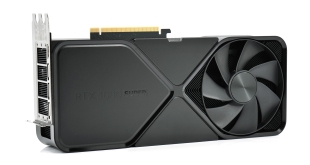
Today marks the end of a busy January launch period for the GPU market, as we check out the RTX 4080 Super. Announced alongside the RTX 4070 Super and 4070 Ti Super back at CES 2024, not only has Nvidia outfitted the 4080 Super with more cores and faster memory than the original model, but it's also had a price cut – down from £1269/$1199 at the 4080's launch, to £959/$999 today. It's still mighty expensive, but does it do enough to tempt those looking for an upgrade?
No doubt about it, the Nvidia RTX 4080 Super is the least exciting of the three 40-series Super refreshes. Even just on paper, the RTX 4070 Super delivered a 22% boost in CUDA cores over the vanilla 4070, while the RTX 4070 Ti Super increased VRAM and memory bandwidth by a third over the 4070 Ti. The RTX 4080 Super however, only ups the CUDA core count by 5%, alongside a 3% increase to memory speeds.
We'll analyse what that means for gaming performance over a wide range of titles, but clearly the 4080 Super is all about the price cut. Back in November 2022, the original 4080 hit the market at £1269 in the UK, or $1199 in the States, and it was almost universally agreed to deliver poor value for money at that price point. Fast-forward just over a year and the 4080 Super has come down in price by over £300, to the MSRP of £959, or $999 USD. Let's find out what that means for those with about a grand to spend on a new GPU…
If you want to read this review as a single page, click HERE.
| RTX 4090 | RTX 4080 Super | RTX 4080 | RTX 4070 Ti Super | RTX 4070 Ti | |
| Process | TSMC N4 | TSMC N4 | TSMC N4 | TSMC N4 | TSMC N4 |
| SMs | 128 | 80 | 76 | 66 | 60 |
| CUDA Cores | 16384 | 10240 | 9728 | 8448 | 7680 |
| Tensor Cores | 512 | 320 | 304 | 264 | 240 |
| RT Cores | 128 | 80 | 76 | 66 | 60 |
| Texture Units | 512 | 320 | 304 | 264 | 240 |
| ROPs | 176 | 112 | 112 | 96 | 80 |
| GPU Boost Clock | 2520 MHz | 2550 MHz | 2505 MHz | 2610 MHz | 2610 MHz |
| Memory Data Rate | 21 Gbps | 23 Gbps | 22.4 Gbps | 21 Gbps | 21 Gbps |
| L2 Cache | 73729 KB | 65536 KB | 65536 KB | 49152 KB | 49152 KB |
| Total Video Memory | 24GB GDDR6X | 16GB GDDR6X | 16GB GDDR6X | 16GB GDDR6X | 12GB GDDR6X |
| Memory Interface | 384-bit | 256-bit | 256-bit | 256-bit | 192-bit |
| Memory Bandwidth | 1008 GB/Sec | 736 GB/Sec | 716.8 GB/Sec | 672 GB/Sec | 504 GB/Sec |
| TGP | 450W | 320W | 320W | 285W | 285W |
First, a quick spec recap. Unlike the RTX 4080 and RTX 4070 Ti which use cut-down versions of the AD103 GPU, the new 4080 Super is a full implementation of AD103 silicon, with the die measuring in at 379mm2. This means the RTX 4080 Super offers a total of 80 Streaming Multiprocessors (SMs), each housing 128 CUDA Cores, for a total of 10240. We also find 80 RT cores, 320 Tensor cores, 320 Texture Units, and 112 ROPs.
TSMC's N4 node has Nvidia cranking up the clock speed significantly this generation, with the RTX 4080 Super sporting a 2550MHz rated boost. That's 45MHz faster than the rated clock speed of the RTX 4080, but we would expect GPU Boost to push things further still.
The memory configuration is almost identical to the RTX 4080, too. The 4080 Super comes equipped with a 256-bit memory interface, paired with 16GB GDDR6X running at 23Gbps, putting total memory bandwidth at 736 GB/s. L2 cache remains unchanged at 65536KB.
Considering the slightly increased core-count, it's interesting that power draw remains the same as the RTX 4080, with the new Super model still boasting a 320W TGP. This is something we focus on closely in this review, using our enhanced GPU power testing methodology, so read on for our most detailed power and efficiency testing yet.
 KitGuru KitGuru.net – Tech News | Hardware News | Hardware Reviews | IOS | Mobile | Gaming | Graphics Cards
KitGuru KitGuru.net – Tech News | Hardware News | Hardware Reviews | IOS | Mobile | Gaming | Graphics Cards




